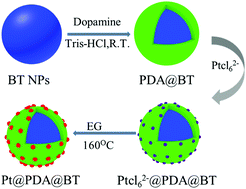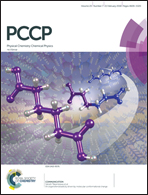Enhancing electrical energy storage capability of dielectric polymer nanocomposites via the room temperature Coulomb blockade effect of ultra-small platinum nanoparticles†
Abstract
Introducing a high dielectric constant (high-k) nanofiller into a dielectric polymer is the most common way to achieve flexible nanocomposites for electrostatic energy storage devices. However, the significant decrease of breakdown strength and large increase of dielectric loss has long been known as the bottleneck restricting the enhancement of practical energy storage capability of the nanocomposites. In this study, by introducing ultra-small platinum (<2 nm) nanoparticles, high-k polymer nanocomposites with high breakdown strength and low dielectric loss were prepared successfully. Core–shell structured polydopamine@BaTiO3 (PDA@BT) and core–satellite ultra-small platinum decorated PDA@BT (Pt@PDA@BT) were used as nanofillers. Compared with PDA@BT nanocomposites, the maximum discharged energy density of the Pt@PDA@BT nanocomposites is increased by nearly 70% because of the improved energy storage efficiency. This research provides a simple, promising and unique way to enhance energy storage capability of high-k polymer nanocomposites.



 Please wait while we load your content...
Please wait while we load your content...